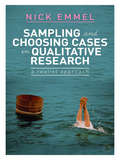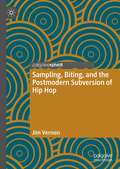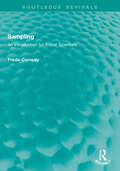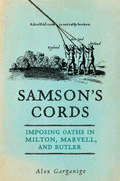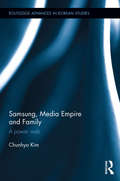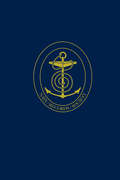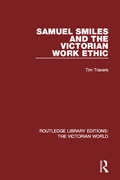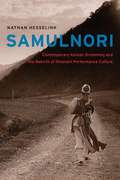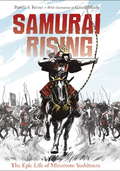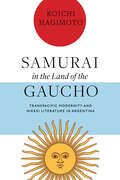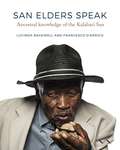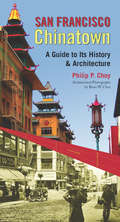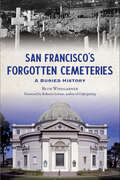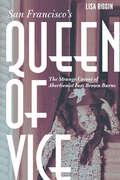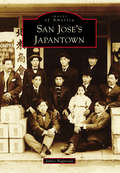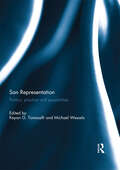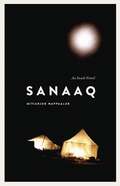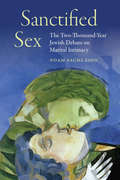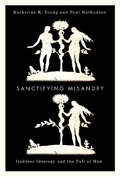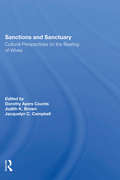- Table View
- List View
Sampling and Choosing Cases in Qualitative Research: A Realist Approach
by Nick EmmelAll qualitative researchers sample, yet methods of sampling and choosing cases have received relatively little attention compared to other qualitative methods. This innovative book critically evaluates widely used sampling strategies, identifying key theoretical assumptions and considering how empirical and theoretical claims are made from these diverse methods. Nick Emmel presents a groundbreaking reworking of sampling and choosing cases in qualitative research. Drawing on international case studies from across the social sciences he shows how ideas drive choices, how cases are used to work out the relation between ideas and evidence, and why it is not the size of a sample that matters, it is how cases are used to interpret and explain that counts. Fresh, dynamic and timely, this book is essential reading for researchers and postgraduate students engaging with sampling and realism in qualitative research.
Sampling, Biting, and the Postmodern Subversion of Hip Hop
by Jim VernonDrawing on the culture’s history before and after the birth of rap music, this book argues that the values attributed to Hip Hop by ‘postmodern’ scholars stand in stark contrast with those that not only implicitly guided its aesthetic elements, but are explicitly voiced by Hip Hop’s pioneers and rap music’s most consequential artists. It argues that the structural evacuation of the voices of its founders and organic intellectuals in the postmodern theorization of Hip Hop has foreclosed the culture’s ethical values and political goals from scholarly view, undermining its unity and progress. Through a historically informed critique of the hegemonic theoretical framework in Hip Hop Studies, and a re-centering of the culture’s fundamental proscription against ‘biting,' this book articulates and defends the aesthetic and ethical values of Hip Hop against their concealment and subversion by an academic discourse that merely ‘samples’ the culture for its own reactionary ends.
Sampling: An Introduction for Social Scientists (Routledge Revivals)
by Freda ConwaySampling (1967) aims to simplify sampling theory for social scientists, many of whom are unwilling mathematicians. It discusses percentages and weighted averages; frequency distributions, their means and variances; experimental and theoretical sampling distributions; problems of estimation and significance; practical sampling schemes and some of the difficulties of devising questionnaires. All these topics are illustrated by practical examples.
Samson’s Cords: Imposing Oaths in Milton, Marvell, and Butler
by Alex GarganigoIn seventeenth-century Britain every debate about loyalty oaths invoked the biblical Samson. Samson’s Cords argues that these loyalty tests became an unprecedentedly pervasive feature of life in Restoration England and that writers of satire and epic had no choice but to respond. Alex Garganigo examines the radically different responses of John Milton, Andrew Marvell, and Samuel Butler to the existential crises caused by this explosion of loyalty oaths. After early support, all three developed serious reservations, confronting the irony that while oaths often exclude and destroy, they also include and create. Tackling issues such as performance, ritual, religion, secularization, gender, swearing, republicanism, and citizenship, Garganigo offers original readings of Paradise Lost, Samson Agonistes, An Horatian Ode upon Cromwell’s Return from Ireland, The Rehearsal Transpros’d, and Hudibras.
Samsung, Media Empire and Family: A power web (Routledge Advances in Korean Studies)
by Chunhyo KimThis book analyses media conglomerates owning multiple media holdings under centralized ownership within and across media markets. It argues that Asian capitalists utilize both a market-oriented ideology and family connections to build their media empires, thereby creating cultural conglomerates that exercise corporate censorship over media markets. It focuses on family-controlled media conglomerates in Korea, specifically the international business giant, Samsung, and its related media companies, Cheil Jedang and JoongAng Ilbo, all of which are controlled by the single Lee family. Utilizing the theoretical approach of political economy of communication, the book examines how and why the Lee family exercise corporate censorship over Korean society. Offering an essential take on Asia’s political economy of communication in order to understand the workings of Asian media empires, this book will appeal to students and scholars of Korean Studies, Korean Business and Mass Communications.
Samuel Pepys and the Second Dutch War: Pepys's Navy White Book and Brooke House Papers
by Pepys SamuelThe two pieces of work which make up this volume were compiled by Pepys in the 1660s. The first is Pepys’s own record of how the Navy Board functioned. It records details of meetings with fellow officers such as Sir William Penn and Sir John Mennes, and how work could be hampered at times by the refusal of an officer to sign a contract or bill as he had not been present at the original discussions.The Navy White Book gives the discussions which took place over a variety of matters, such as, contracts with Sir William Warren, a timber merchant; costs and quality of masts and canvas.The Brooke House Papers deal with the inquiry set up by the House of Commons into the conduct of the Second Dutch War, following the humiliation of the Dutch invasion of 1667, and the inefficiency of the Navy Board. The Brooke House Papers further show Pepys defending the Navy Board’s professionalism and integrity, and also that naval administration during the Second Dutch War was efficient. The Papers also show Charles II ‘s role in protecting the Navy Board, by making his dissatisfaction with the inquiry known, through his disrespectful language and interruptions, as well as his support for Pepys, whom he makes the Board’s spokesman.
Samuel Ringgold Ward: A Life of Struggle (Black Lives)
by R. J. BlackettThe rediscovery of a pivotal figure in Black history and his importance and influence in the struggle against slavery and discrimination Born on the Eastern Shore of Maryland, Samuel Ringgold Ward (1817–c. 1869) escaped enslavement and would become a leading figure in the struggle for Black freedom, citizenship, and equality. He was extolled by his contemporary Frederick Douglass for his &“depth of thought, fluency of speech, readiness of wit, logical exactness.&” Until now, his story has been largely untold. Ward, a newspaper editor, Congregational minister, and advocate for the temperance movement, was considered one of the leading orators of his time. After the passage of the Fugitive Slave Act of 1850 he fled to Canada, where he lectured widely to improve conditions for formerly enslaved people who had settled there. Ward then went to Britain as an agent of the Canadian Antislavery Society and published his influential book Autobiography of a Fugitive Negro. He never returned to the United States, and he died in obscurity in Jamaica. Despite Ward&’s prominent role in the abolitionist movement, his story has been lost because of the decades he spent in exile. In this book, R. J. M. Blackett brings light to Ward&’s life and his important role in the struggle against slavery and discrimination, and to the personal price he paid for confronting oppression.
Samuel Smiles and the Victorian Work Ethic (Routledge Library Editions: The Victorian World #49)
by Tim TraversSamuel Smiles is best known for his book Self Help (1859), which many have assumed to be an encouragement to social and financial success. However, Smiles actually argued against the single-minded pursuit of success, and in favour of the protean formation of character as the ultimate goal of life. First published in 1987, this book examines Samuel Smiles’ ideals of work and self-help against the background of the Victorian work ethic. Drawing on ‘sub-literature’ such as pamphlets, periodicals, novels, works by Dissenting and Anglican ministers, popular ‘success’ and ‘self-improvement’ books, and general literature on the condition of the working classes, it presents a broad range of public opinion and attitudes towards work and in doing so, creates an essential framework and context for Smiles’ popular books. This book will be of interest to those studying Victorian history and ideology.
SamulNori
by Nathan HesselinkIn 1978, four musicians crowded into a cramped basement theater in downtown Seoul, where they, for the first time, brought the rural percussive art of p'ungmul to a burgeoning urban audience. In doing so, they began a decades-long reinvention of tradition, one that would eventually create an entirely new genre of music and a national symbol for Korean culture. Nathan Hesselink's SamulNori traces this reinvention through the rise of the Korean supergroup of the same name, analyzing the strategies the group employed to transform a museum-worthy musical form into something that was both contemporary and historically authentic, unveiling an intersection of traditional and modern cultures and the inevitable challenges such a mix entails. Providing everything from musical notation to a history of urban culture in South Korea to an analysis of SamulNori's teaching materials and collaborations with Euro-American jazz quartet Red Sun, Hesselink offers a deeply researched study that highlights the need for traditions--if they are to survive--to embrace both preservation and innovation.
SamulNori: Contemporary Korean Drumming and the Rebirth of Itinerant Performance Culture (Chicago Studies in Ethnomusicology)
by Nathan HesselinkIn 1978, four musicians crowded into a cramped basement theater in downtown Seoul, where they, for the first time, brought the rural percussive art of p’ungmul to a burgeoning urban audience. In doing so, they began a decades-long reinvention of tradition, one that would eventually create an entirely new genre of music and a national symbol for Korean culture. Nathan Hesselink’s SamulNori traces this reinvention through the rise of the Korean supergroup of the same name, analyzing the strategies the group employed to transform a museum-worthy musical form into something that was both contemporary and historically authentic, unveiling an intersection of traditional and modern cultures and the inevitable challenges such a mix entails. Providing everything from musical notation to a history of urban culture in South Korea to an analysis of SamulNori’s teaching materials and collaborations with Euro-American jazz quartet Red Sun, Hesselink offers a deeply researched study that highlights the need for traditions—if they are to survive—to embrace both preservation and innovation.
Samurai Rising: The Epic Life of Minamoto Yoshitsune
by Pamela S. Turner Gareth HindsMinamoto Yoshitsune should not have been a samurai. But his story is legend in this real-life Game of Thrones. This epic tale of warriors and bravery, rebellion and revenge, reads like a novel, but this is the true story of the greatest samurai in Japanese history. <P><P>When Yoshitsune was just a baby, his father went to war with a rival samurai family--and lost. His father was killed, his mother captured, and his brothers sent away. Yoshitsune was raised in his enemy's household until he was sent away to live in a monastery. He grew up skinny and small. <P>Not the warrior type. But he did inherit his family pride and when the time came for the Minamoto to rise up against their enemy once again, Yoshitsune was there. <P>His daring feats, such as storming a fortress by riding on horseback down the side of a cliff and his glorious victory at sea, secured Yoshitsune's place in history and his story is still being told centuries later.
Samurai among Panthers: Richard Aoki on Race, Resistance, and a Paradoxical Life (Critical American Studies)
by Diane C. FujinoAn iconic figure of the Asian American movement, Richard Aoki (1938–2009) was also, as the most prominent non-Black member of the Black Panther Party, a key architect of Afro-Asian solidarity in the 1960s and &’70s. His life story exposes the personal side of political activism as it illuminates the history of ethnic nationalism and radical internationalism in America. A reflection of this interconnection, Samurai among Panthers weaves together two narratives: Aoki&’s dramatic first-person chronicle and an interpretive history by a leading scholar of the Asian American movement, Diane C. Fujino. Aoki&’s candid account of himself takes us from his early years in Japanese American internment camps to his political education on the streets of Oakland, to his emergence in the Black Panther Party. As his story unfolds, we see how his parents&’ separation inside the camps and his father&’s illegal activities shaped the development of Aoki&’s politics. Fujino situates his life within the context of twentieth-century history—World War II, the Cold War, and the protests of the 1960s. She demonstrates how activism is both an accidental and an intentional endeavor and how a militant activist practice can also promote participatory democracy and social service. The result of these parallel voices and analysis in Samurai among Panthers is a complex—and sometimes contradictory—portrait of a singularly extraordinary activist and an expansion and deepening of our understanding of the history he lived.
Samurai in the Land of the Gaucho: Transpacific Modernity and Nikkei Literature in Argentina
by Koichi HagimotoIn the early twentieth century, historical imaginings of Japan contributed to the Argentine vision of &“transpacific modernity." Intellectuals such as Eduardo Wilde and Manuel Domecq García celebrated Japanese customs and traditions as important values that can be integrated into Argentine society. But a new generation of Nikkei or Japanese Argentines is rewriting this conventional narrative in the twenty-first century. Nikkei writers such as Maximiliano Matayoshi and Alejandra Kamiya are challenging the earlier, unapologetic view of Japan based on their own immigrant experiences. Compared to the experience of political persecution against Japanese immigrants in Brazil and Peru, the Japanese in Argentina generally lived under a more agreeable sociopolitical climate. In order to understand the "positive" perception of Japan in Argentine history and literature, Samurai in the Land of the Gaucho turns to the current debate on race in Argentina, particularly as it relates to the discourse of whiteness. One of the central arguments is that Argentina's century-old interest in Japan represents a disguised method of (re)claiming its white, Western identity. Through close readings of diverse genres (travel writing, essay, novel, short story, and film) Samurai in the Land of the Gaucho yields a multi-layered analysis in order to underline the role Japan has played in both defining and defying Argentine modernity from the twentieth century to the present.
San Elders Speak: Ancestral knowledge of the Kalahari San
by Lucinda Backwell Francesco d'ErricoThis richly illustrated book documents indigenous knowledge and uses of San material culture and artefacts collected a century ago, as described by KhoiSan elders to the authors.
San Francisco Chinatown
by Philip P. ChoySan Francisco Chinatown is the first "insider's guide" to one of America's most celebrated ethnic enclaves by an author born and raised there. Both a history of America's oldest Chinese community and a guide to its significant sites and architecture, San Francisco Chinatown traces the development of the neighborhood from the city's earliest days to its post-quake transformation into an "oriental" tourist attraction as a pragmatic means of survival. Written by architect and Chinese American studies pioneer Philip P. Choy, and featuring photographs and walking tours, the book details the triumphs and tragedies of the Chinese American experience in the United States.
San Francisco's Forgotten Cemeteries: A Buried History (The History Press)
by Beth WinegarnerDigging into a forgotten past - and the dead left behind. San Francisco is famous for not having any cemeteries, but the claim isn't exactly what it seems. In the early 20th Century, the city relocated more than 150,000 graves to the nearby town of Colma to make way for a rapidly growing population. But an estimated fifty to sixty thousand burials were quietly built over and forgotten, only to resurface every time a new building project began. The dead still lie beneath some of the city's most cherished destinations, including the Legion of Honor, United Nations Plaza, the Asian Art Museum and the University of San Francisco. Join author Beth Winegarner as she maps the city's early burial grounds and brings back to life the dead who've been erased.
San Francisco's Queen of Vice: The Strange Career of Abortionist Inez Brown Burns
by Lisa RigginSan Francisco’s Queen of Vice uncovers the story of one of the most skilled, high-priced, and corrupt abortion entrepreneurs in America. Even as Prohibition was the driving force behind organized crime, abortions became the third-largest illegal enterprise as state and federal statutes combined with changing social mores to drive abortionists into hiding. Inez Brown Burns, a notorious socialite and abortionist in San Francisco, made a fortune providing her services to desperate women throughout California. Beginning in the 1920s, Burns oversaw some 150,000 abortions until her trial and conviction brought her downfall. In San Francisco’s Queen of Vice, Lisa Riggin tells the story of the rise and fall of San Francisco’s “abortion queen” and explores the rivalry between Burns and the city’s newly elected district attorney, Edmund G. “Pat” Brown (father of the present governor of California). Pledging to clean up the graft-ridden city, Brown exposed the hidden yet not-so-secret life of backroom deals, political payoffs, and corrupt city cops. Through the arrest, prosecution, and conviction of Burns, Brown used his success as a stepping-stone for his political rise to California’s governor’s mansion. Featuring an array of larger-than-life characters, Riggin shows how Cold War domestic ideology and the national quest to return to a more traditional America quickly developed into a battle against internal decay. Based on a combination of newspaper accounts, court records, and personal interviews, San Francisco’s Queen of Vice reveals how the drama played out in the life and trial of one of the wealthiest women in California history.
San Jose's Japantown (Images of America)
by James NagaredaThe Japanese started to arrive in San Jose, California, around 1890 in the Heinlenville area, which was once on the outskirts of the city. Many of the businesses that the Japanese opened would serve the needs of the growing Japanese population, who came to the Santa Clara Valley to take advantage of opportunities in the agricultural industry. Out of 46 Japantowns, only three remain in California. San Jose�s Japantown is unique in that it is the only surviving Japantown that has remained in its original location. Today, San Jose�s Japantown is a thriving and evolving mix of traditional and contemporary arts, culture, and lifestyle.
San José de Gracia: Mexican Village in Transition
by John Upton Luis GonzálezThe village of San José de Gracia is not mentioned in any history of Mexico, nor is it referred to in any of the annals of the state of Michoacán. It is not to be found at all on most maps, and almost none show its correct location. It is an unknown point in space, in time, and in the consciousness of the Mexican republic. In Luis González's classic history of the world of San José, he turns his attention in every direction: toward what is lasting and what is ephemeral, everyday and unusual, material and spiritual. The story is, to some extent, the story of rural life anywhere, in any age; to some extent it is peculiar to the world of the peasant all through Mexico's history; and to some extent it can be said to be true only of San José. The history of San José is also the history of the village as victim of the megalopolis, not only in Mexico but everywhere in our time. With the small community will be lost traditions and a sense of continuity that may prove irreplaceable and essential to human well-being. While Luis González does not suggest that he knows what the fate of San José will be, one feels that he knows all too well, and that his questions are only "How?" and "How soon?"
San Representation: Politics, Practice and Possibilities
by Michael Wessels Keyan G. TomaselliThe San or Bushmen of southern Africa have exerted a fascination over generations of writers and scholars, from novelists and anarchists to ethnologists and geneticists, and also occupy a special place in the popular imagination as the First People and the contemporary remnant of spiritual and natural man. The ways in which particular groups of people from southern Africa have been traditionally categorised and positioned as objects of scrutiny by a range of academic disciplines is increasingly being contested and questioned. There is a growing awareness of the cultural, economic and genetic entanglement of the peoples of the region. This book examines how San and Khoe people are represented, by others, as well as by those who identify as San or Khoe. The book interrogates the ways in which disciplines, through their methodologies and ways of authorising knowledge, not only "discover" or "reveal" knowledge but produce it in ways that involve complex and often ambiguous relationships with power structures and forms of intellectual, symbolic and cultural capital. One major trend that emerges is that the San and Khoe can no longer be seen as people of the past but have to be acknowledged as contemporary and socially situated individuals and communities who are increasingly contesting the representations which others have imposed on them. This book was originally published as a special issue of Critical Arts: A Journal of South-North Cultural and Media Studies.
Sanaaq: An Inuit Novel
by Mitiarjuk Nappaaluk Bernard Saladin D'Anglure Peter FrostSanaaq is an intimate story of an Inuit family negotiating the changes brought into their community by the coming of the qallunaat, the white people, in the mid-nineteenth century. Composed in 48 episodes, it recounts the daily life of Sanaaq, a strong and outspoken young widow, her daughter Qumaq, and their small semi-nomadic community in northern Quebec. Here they live their lives hunting seal, repairing their kayak, and gathering mussels under blue sea ice before the tide comes in. These are ordinary extraordinary lives: marriages are made and unmade, children are born and named, violence appears in the form of a fearful husband or a hungry polar bear. Here the spirit world is alive and relations with non-humans are never taken lightly. And under it all, the growing intrusion of the qallunaat and the battle for souls between the Catholic and Anglican missionaries threatens to forever change the way of life of Sanaaq and her young family.
Sanctified Sex: The Two-Thousand-Year Jewish Debate on Marital Intimacy
by Noam Sachs ZionSanctified Sex draws on two thousand years of rabbinic debates addressing competing aspirations for loving intimacy, passionate sexual union, and sanctity in marriage. What can Judaism contribute to our struggles to nurture love relationships? What halakhic precedents are relevant, and how are rulings changing? The rabbis, of course, seldom agree. Underlying their arguments are perennial debates: What kind of marital sex qualifies as ideal—sacred self-control of sexual desire or the holiness found in emotional and erotic intimacy? Is intercourse degrading in its physicality or the highest act of spiritual/mystical union? And should women or men (or both) wield ultimate say about what transpires in bed? Noam Sachs Zion guides us chronologically and steadily through fraught terrain: seminal biblical texts and their Talmudic interpretations; Talmud tales of three unusual rabbis and their marital bedrooms; medieval codifiers and mystical commentators; ultra-Orthodox rabbis clashing with one another over radically divergent ideals; and, finally, contemporary rabbis of varied denominations wrestling with modern transformations in erotic lifestyles and values. Invited into these sanctified and often sexually explicit discussions with our ancestors and contemporaries, we encounter innovative Jewish teachings on marital intimacy, ardent lovemaking techniques, and the art of couple communication vital for matrimonial success.
Sanctifying Misandry
by Katherine K. Young Paul NathansonHow some feminists have used religion to turn the "Fall of Man" into the fall of men.
Sanctifying Misandry: Goddess Ideology and the Fall of Man
by Katherine K. Young Paul NathansonHow some feminists have used religion to turn the "Fall of Man" into the fall of men.
Sanctions And Sanctuary: Cultural Perspectives On The Beating Of Wives
by Dorothy A Counts Judith K Brown Jacquelyn C CampbellBringing together evidence from 15 Western and non-Western societies - ranging from hunter-gatherers to urban Americans - this book examines wife-beating from a worldwide perspective. Cross-cultural comparison aims to give a more accurate picture of cultural influences on wife-battering and to show the commonalities and differences of the phenomeno
